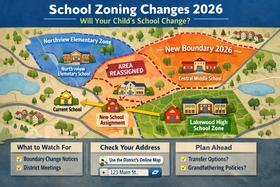As a parent, it is your job to worry about your child but worrying won’t protect him or her. When you send your child to school, you are giving up control and placing his care in the hands of his teachers and administrators. If your child suffers from a food allergy, going to school could put him at risk for accidental exposure to his allergen.
While you can’t enclose your child in a plastic bubble to protect him, there are simple steps you can take to keep him safe at school. Keep reading to learn more about food allergies in children and to receive tips for keeping your child safe when he is at school.
This video explains parents' concerns about sending their allergy-prone children to school.
How Common Are Food Allergies in Children?
According to the Food Allergy Research & Education Corporation, there are more than 170 foods that have been reported to cause allergic reactions. The eight primary food allergens are milk, egg, peanut, tree nuts, wheat, soy, fish, and shellfish. Current estimates suggest that roughly 15 million Americans suffer from food allergies, including nearly 6 million children under the age of 18.
A food allergy is more than just a sensitivity to a certain type of food – it is a medical condition triggered by exposure to an allergen that induces a harmful immune response in the body. Allergies can range in severity, but some of the most common symptoms include the following:
- Difficulty breathing
- Wheezing
- Coughing
- Hoarseness
- Throat tightness
- Vomiting
- Diarrhea
- Itchy eyes
- Swollen eyes
- Stomach pain
- Hives
- Swelling
In some cases, you may also experience a drop in blood pressure which can cause you to feel light-headed or to pass out. Ingesting a food you’re allergic to causes the immune system to produce antibodies to fight the allergen and, in doing so, triggers the release of chemicals like histamine which can affect the gastrointestinal tract, the skin, and the respiratory and cardiovascular systems.
As common as food allergies are, the Centers for Disease Control and Prevention (CDC) report that food allergies are becoming even more common. In fact, between 1997 and 2011, the prevalence of food allergies in children increased by 50%. Additionally, between 1997 and 2008, the prevalence of tree nut and peanut allergies more than tripled in U.S. children.
How to Protect a Child with a Food Allergy at School
Food allergies have the potential to be quite serious and, in some cases, they can even be fatal. According to the Food Allergy Research & Education Corporation, food allergies send someone to the emergency room every three minutes. Overall, more than 200,000 people require emergency medical attention for allergic reactions to food each year.
If your child has a food allergy, you’ve probably already learned how to handle it. You probably keep an EpiPen on hand at all times and take steps to make sure your child isn’t accidentally exposed to the food he is allergic to. Unfortunately, you can’t be with your child at all times – like when he is at school.
In this video, Dr. B.J. Lanser offers some tips for sending your child with allergies to school.
While you can’t physically follow your child to school and examine his lunch to make sure it is safe, there are steps you can take to make sure he is protected at school. Here are some things you should do:
1. Meet with school staff before the school year starts. When your child is walking into the building on the first day of school is not the best time to start thinking about his food allergy. Schedule meetings with your child’s principal and teachers as well as the school nurse and cafeteria staff before the school year begins to inform them of your child’s allergy. It is likely that the school staff will already have protocols in place for food allergies, but you should take this step anyway. At the very least, you’ll learn exactly what steps the school has put into place to protect children with food allergies.
2. Create a written guide for your child to carry. Depending on how old your child is, he may have some understanding of his food allergy – or he might not. Even if the school already has policies in place, it never hurts to be prepared. If your child has a written guide for how to handle his food allergy, he will have it on hand in case anyone has a question. Make sure to include detailed information about the food(s) your child is allergic to as well as tips for avoiding accidental exposure. You should also provide information about how to recognize and treat symptoms of an allergic reaction.
3. Talk to your child’s classmates and educate them if needed. All your child wants to do is fit in at school and make friends. Having a food allergy can be an isolating factor that prevents him from doing things his classmates might be doing. It can also put your child at risk for bullying because children often respond negatively to things they don’t understand. One way to avoid this is to talk to your child’s teacher about making a presentation to the class about food allergies so they understand why your child is different. If there are other children with food allergies in the class, you can include them as well!
4. Be an active participant in your child’s school. When meeting with your child’s school staff, you will come to see what policies they already have (or don’t have) in place to protect children with food allergies. If you feel like there is room for improvement, step up and start taking action to make those improvements! Teachers and administrators are busy enough with your child’s education, so if you want to make a change to school policy then you may need to make it happen yourself. Drum up support from other parents and local organizations and help create a plan that will benefit all children with food allergies.
5. Make sure your child has plenty of safe snacks to eat. Depending on what your child is allergic to, you might prefer to pack his lunch rather than run the risk of accidental exposure with school lunches. Even so, there will be times when snacks are made available and you don’t want your child to miss out due to his allergy. It’s a good idea to send your child to school with some safe and healthy snacks, but you should also provide some for your child’s teachers. If a special event calls for a snack in the classroom, your child will still have something to eat even if he can’t eat what’s offered.
In addition to talking to your child’s school staff about his allergy, you should also make sure that your child has a good understanding of his allergy. Simply telling him that he can’t eat peanuts is not enough – he needs to understand just how serious things could become if he isn’t careful. Your goal isn’t to scare your child, but to help him understand that he needs to protect himself as well.
Recognizing and Responding to a Food Allergy
Not only do you need to know how to recognize the signs of an allergic reaction in your child, but you need to be able to teach others to do so as well. In some cases, an allergic reaction may be fairly mild, causing little more than a rash or hives. In other cases, however, it can be severe enough to trigger anaphylaxis which is a life-threatening condition.
We’ve already reviewed the symptoms of food allergy, but being able to identify the signs of anaphylaxis is a little different. Severe symptoms that necessitate emergency medical attention may include:
- Trouble swallowing
- Wheezing or shortness of breath
- Turning blue in the face
- Feeling faint, weak, or confused
- Losing consciousness
- Blacking out or passing out
- Chest pain or tightness
- A weak pulse
- A feeling of impending doom
If your child experiences any of these symptoms, do not delay in seeking immediate medical attention. Make sure that anyone who cares for your child also knows how to recognize these symptoms and what to do in response. You should always have an EpiPen nearby, just in case, and you should make sure that your child’s teachers and caregivers know how to use it.
Mount Sinai Health System offers tips on diagnosing allergies.
Food allergies are no laughing matter and it doesn’t take long for a reaction to become serious and potentially fatal. If your child has a food allergy, follow the tips above to ensure his safety when he is at school or away from home.
Questions? Contact us on Facebook. @publicschoolreview















